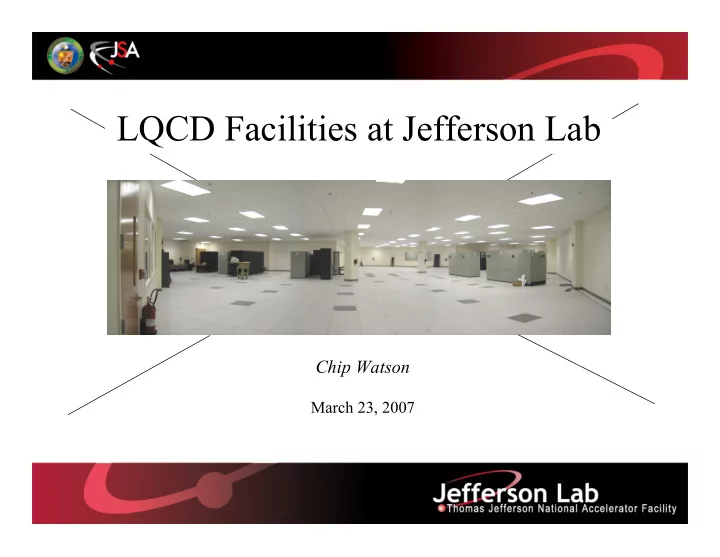

LQCD Facilities at Jefferson Lab Chip Watson March 23, 2007 Page 1 January 24, 2007
Existing Clusters 3g 2003 gigE mesh 2.66 GHz P4, 256 MB / node ½ decommissioned, now just 128 nodes no allocation this next year 4g 2004 gigE mesh 2.8 GHz P4, 512 MB/node 384 nodes, 3 sets of 128 start to decommission in 2008 6n 2006 infiniband 3.0 GHz Pentium-D 1 GB/node 280+ nodes Page 2 January 24, 2007
FY 2007 Cluster Goals: Formal goal: 2.9 Teraflop/s sustained <asqtad,dwf>, & deploy by June 30 Science goal: get the most capacity that $1.4M can buy, & deploy as fast as possible Best Value RFP Process – Explicitly described a cluster of ~800 processors with infiniband fabric (to guide vendors toward good solution) – Allowed for ANYTHING (specifically wanted to all room for a BG/L proposal to compete) – Included anisotropic clover as one of three benchmarks – Chose local volumes corresponding to anticipated real jobs (not artificial “best performance” numbers) Page 3 January 24, 2007
Proposals Single node performance, showing breadth of potential solutions: action: asqtad clover dwf bandwidth <as,cl,dwf> per core 12^4 12x6x6x32 28x8x8x32 local vol: $/MF 1 dual core 3530 2487 4800 1500 $0.51 Xeon 2.66 1 quad core 2540 3520 4400 715 - 900 $0.78 Xeon 2.33 2 dual core 4630 4800 7491 1325 $0.56 Xeon 2.66 2 quad core 4200 12000 5600 400 $0.51 Xeon 233 2 dual core 4900 4040 6560 1750 $0.49 AMD 2.6 amd w/ 1 GB 5140 4400 6950 1975 dimms (not 512) Page 4 January 24, 2007
Winning Proposal Vendor: Koi (“whitebox”, same supplier as Kaon at FNAL) Node: – dual cpu, dual core AMD 2218, 2.6 GHz – DDR (20g) infiniband, 18:6 leaf switch oversubscription – ASUS KFN4 motherboard; IPMI 2.0 Interesting Option: Upgrade to quad core Opterons at steeply discounted price – doubles number of cores – doubles SSE issue rate / cycle (to match Intel) – 2 MB L3 shared cache, + ½ MB L2/core (effectively doubles cache) – same power envelope (2.1 GHz vs 2.6 GHz) Page 5 January 24, 2007
Projecting Quad Core Performance Reasoning: • dual - dual core Xeons get the most flop/s per MB/sec of memory bandwidth (streams triad) – i.e. Xeons have enough peak flop/s to consume bandwidth • Raw flops of quads will be 3x faster than Opteron duals (2x cores, 2x issue rate, ¾ clock speed) • With this increase, Opteron will also be memory bound, like the Xeons • Opterons have 50% - 60% more memory bandwidth than Xeons • Therefore, quad cores should have ~ 50% performance boost 20% cost, and delay of ~3 months on just 20% of funds (clear win) In addition: • Hyper transport bus & Opteron cache protocols are better at multi-threading, yielding additional architectural advantages Page 6 January 24, 2007
Modifying the proposal • Preliminary decision to hold back 20% of the funds to be able to do the quad core upgrades (no real impact, since continuing resolution kept those funds from Jlab anyway) – increase memory / node to 4 GBytes (higher density, better performance for some reason) – decrease node count to 400 • In May, evaluate quad core chips in one of our nodes, verify that we get price/performance boost • Order quads OR order additional 20% nodes • Quad chips might take 3 months to receive (high initial demand); install as late as September Page 7 January 24, 2007
7n Timeline April : machine installation (mid month for racks, later for long cables) May : friendly user mode on 400 dual-duals separate PBS server & queue, for 64 bit O/S 2 of the nodes used as 64 bit interactive & build/test with 8 GB / node June : production on 400 dual-duals July : convert 6n to 64 bit; decommission old interactive nodes September : rolling outages to upgrade to quads Optimistic Result: 2.9 TFlop/s deployed in FY 2007 Page 8 January 24, 2007
File Server Upgrade Currently have 5 servers from 1 to 4 years old; total of 15 TBytes, but reliability decreasing. Disk Allocation is currently by project; each server = 1-3 projects (avoids need for disk management software & manpower) But: some projects need more than 5 TBytes (largest server) Next step: 3x disk capacity increase to match 3x computing performance increase. Option 1: many small terabyte servers + software (like dCache) Option 2: a few larger, faster servers a single project still lives on single server (easy “flat” namespace management); servers cost more, but much less manpower expense; single stream performance advantage (good for bursty load) Page 9 January 24, 2007
Mid Range File Servers Goals: • >200 MB/sec streaming single file into head node of job (avoid need for parallel file system, re-writing aplications) • Feed data in via infiniband fabric, avoiding completely the cost of a gigE fabric – saved $20K by using less expensive fast ethernet – achieve bandwidth goals (impossible via gigE) Presently Evaluating • Sun's Thumper - Sun Fire X4500: zfs, PCI-X infiniband HCA – 18 TBytes / box (could use one per large project) – 550 MB / sec disk to memory!!! • Agami's AIS6119 – 12 gigE links; no direct IB connectivity – IB gateway via 4 trunked gigE connections (router, or use one node) • Others being considered Page 10 January 24, 2007
Infrastructure Upgrade Summary • Disk Cache – 15 TB going to 45+ TB • Wide Area Networking – Upgraded this past year to 10g • Local Area Networking – Bandwidth: file server to silo going to 10g • Power – Over next 2 years add 1 Megawatt UPS – Over next 5 years add equivalent cooling capacity Page 11 January 24, 2007
QUESTIONS ? Page 12 January 24, 2007
Recommend
More recommend